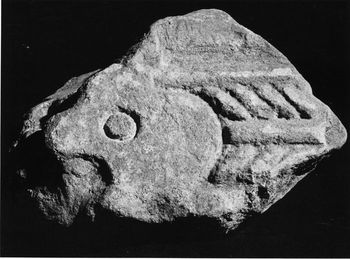Corpus of Anglo-Saxon Stone Sculpture
Durham University, 2019. (updated 2020)
Data copyright © Durham University unless otherwise stated
This work is licensed under the ADS Terms of Use and Access.
Primary contact
Durham University
South Road
Durham
DH1 3LE
England
Resource identifiers
- ADS Collection: 351
Hexham 20, Northumberland
| Overview | ||
|---|---|---|

|
Object Type | Fragment of animal frieze(?) or step(?) [1] | Measurements | H. 19 cm (7.5 in); W. 23.5 cm (9.25 in); D. 11.5 cm (4.5 in) | Stone Type | Sandstone | Plate Numbers In Printed Volume | 956,957 | Corpus Volume Reference | 184-185 |
| See table below for more views or larger images available for this item. Click on the thumbnail images to preview larger images. | ||
| Images | |||
|---|---|---|---|

|
Hexham 20A (Plate no. 956) Corpus of Anglo-Saxon Stone Sculpture, University of Durham |
JPG | 2 Mb |

|
Hexham 20B (Plate no. 957) Corpus of Anglo-Saxon Stone Sculpture, University of Durham |
JPG | 1 Mb |
| National Grid Reference of Place of Discovery | ||
|---|---|---|
| NY935641 | ||
| Latitude | ||
| 54.971474 | ||
| Longitude | ||
| -2.103069 | ||
| Diocese | ||
| Newcastle | ||
| Present Location | ||
| South aisle of choir of abbey | ||
| Evidence for Discovery | ||
| None. First noticed by R. Cramp in 1972 | ||
| Church Dedication | ||
| St Andrew | ||
| Present Condition | ||
| Damaged but unworn | ||
| Date | ||
| Last quarter of seventh century | ||
| Earliest Date | ||
| 675 | ||
| Latest Date | ||
| 700 | ||
| Geological Period | ||
| Unspecified | ||
| Description | ||
| Only one face is carved. A (long): The head and part of the body of a fish with a broad slightly chamfered upper border. The jaws of the fish are gaping, the eye rounded. Its body is conveyed by a herring-bone effect on either side of a broad central rib. The surface is covered by a white undercoat, presumably for paint. | ||
| Discussion | ||
| The deep cutting and the smooth dressing of the surface, even the treatment of the eye, is closely similar to 33 and 34. The herring-bone ornament is paralleled on imposts 26 and 28. It seems evident that these pieces belong to the same tradition of carving if not the same scheme (Introduction, p. 19). The fish with its carp-like head and rounded gaping jaws is quite unlike all the reptilian creatures of Style II and its derivatives, as for example on the jambs of the porch at Monkwearmouth (no. 8). At the hypogeum at Poitiers fish-like creatures are found on steps, and this could be a similar architectural feature (Introduction, p. 25; Hubert, Porcher and Volbach 1969, pls. 68, 70). | ||
| References | ||
| Cramp 1974, 120, 175, pl. 10C | ||
| Endnotes | ||
| 1. The following are general references to the Hexham stones: (—) 1855-7a, 45-6; Rowe 1877, 62-3; Allen 1889, 230; Bailey 1980, 79, 81, 83. | ||
| Subjects | ||
|---|---|---|
| Monument Form: Architectural | ||
| Monument Type: Frieze | ||
| Monument Feature: Animal | ||
| Monument Period (MIDAS term): Early Medieval | ||
| Horizon: Pre 920 | ||




